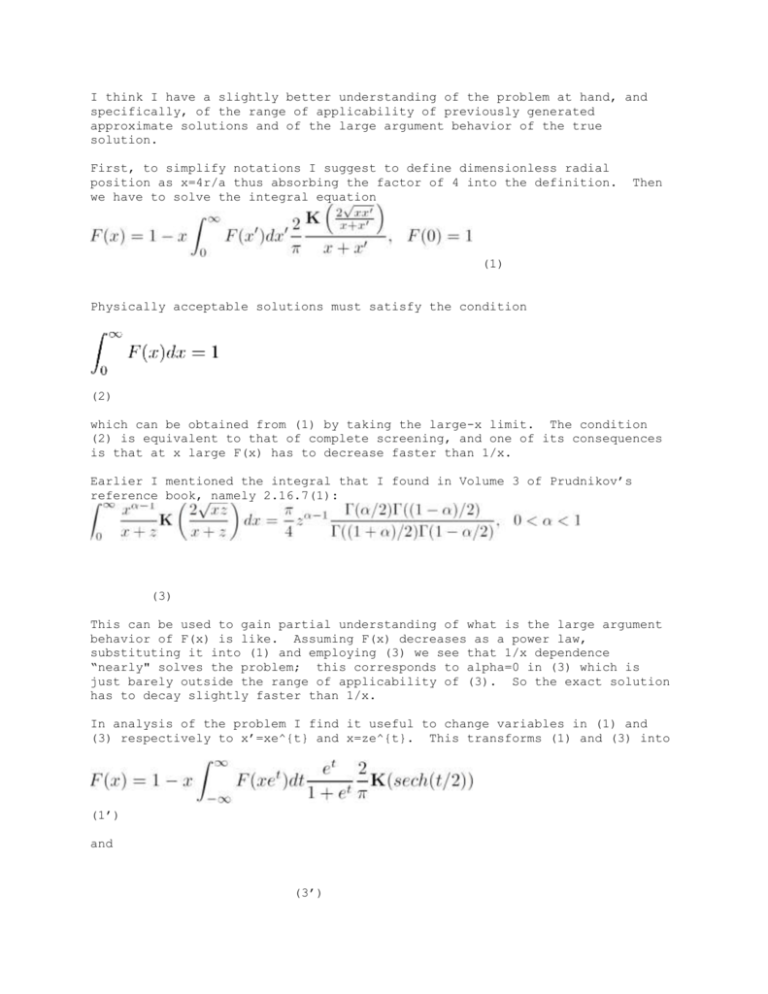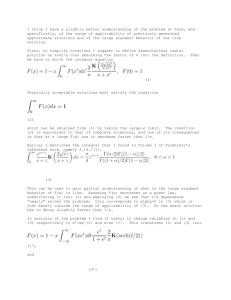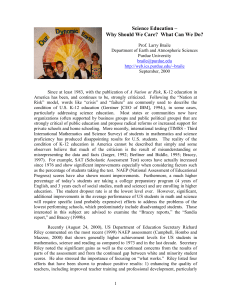Solutions
advertisement

I think I have a slightly better understanding of the problem at hand, and
specifically, of the range of applicability of previously generated
approximate solutions and of the large argument behavior of the true
solution.
First, to simplify notations I suggest to define dimensionless radial
position as x=4r/a thus absorbing the factor of 4 into the definition.
we have to solve the integral equation
Then
(1)
Physically acceptable solutions must satisfy the condition
(2)
which can be obtained from (1) by taking the large-x limit. The condition
(2) is equivalent to that of complete screening, and one of its consequences
is that at x large F(x) has to decrease faster than 1/x.
Earlier I mentioned the integral that I found in Volume 3 of Prudnikov’s
reference book, namely 2.16.7(1):
(3)
This can be used to gain partial understanding of what is the large argument
behavior of F(x) is like. Assuming F(x) decreases as a power law,
substituting it into (1) and employing (3) we see that 1/x dependence
“nearly" solves the problem; this corresponds to alpha=0 in (3) which is
just barely outside the range of applicability of (3). So the exact solution
has to decay slightly faster than 1/x.
In analysis of the problem I find it useful to change variables in (1) and
(3) respectively to x’=xe^{t} and x=ze^{t}. This transforms (1) and (3) into
(1’)
and
(3’)
Approximate solutions generated earlier were based on the two identities
(4)
and
(5)
Here theta(t) is the step function. These identities can be proven with the
help of (3’) by taking limiting transition of alpha—>0 or alpha—>1. In fact
(4) and (5) are really one identity related by the transformation t—>-t, i.e.
g(t)=phi(-t).
The functions g and phi are sharply peaked at t=0 and
decrease rapidly as one goes away from t=0. Approximate treatments were
based on approximating the g and phi functions by delta-functions, namely
(ln4)\delta(t); both of these neglect the fact that the divergence of g and
phi at t=0 is slightly asymmetric, i.e. g and phi are not even.
If x is small, it is more appropriate to substitute (4) into (1’), and then
approximating g(t)=(ln4) delta(t) we arrive at the second approximate
solution
(except that the change of variables in the first paragraph makes xi = x).
That solution exhibits the right x—>0 behavior (which could already be
inferred from (1)) but for x large predicts exactly the 1/x decay which, we
know, is not the right answer; the true behavior is however “close" to it.
Since we know that for x large the true solution decays “close" to the 1/x
dependence, it is now more appropriate to use (5) and substitute
phi(t)=(ln4)delta(t). This generates the first approximate solution
(here 4x should be replaced by x). That solution does not get the small-x
behavior quite right but satisfies the normalization condition (2) and
predicts a decay with an exponent large than unity. It is not slightly
larger than unity as the continuity argument above implies but I can explain
it by the fact that in contrast to the small-argument behavior of F which is
known exactly the large argument behavior is not known and approximation
based on (5) may not be the best possible to capture the large-x behavior of
F.
So I expect the second approximate solution to be acceptable for all x except
for largest; the true large x decay of F(x) is probably a power law (and if
it is a power law) with the decay exponent between 1 and 1+1/ln(4).
Certainly it can be a 1/x with some powers of logarithm which would not be
good because probably it would be very difficult to detect numerically.
This is my assessment of the situation.
OK, but the two solutions are a bit different – if I have all the factors of
4 right, the blue curve is the second solution (falling off as 1/x) and the
red curve is the first solution (falling off as a higher power of x)












